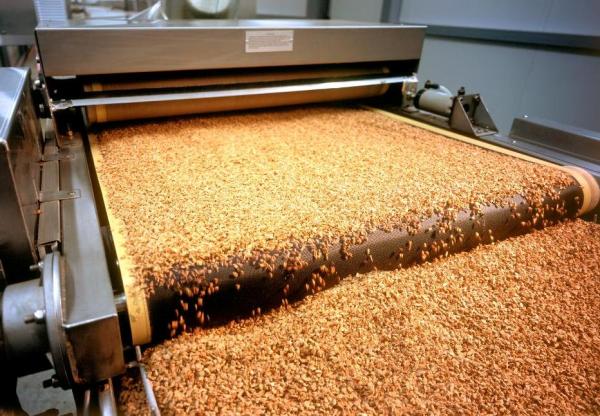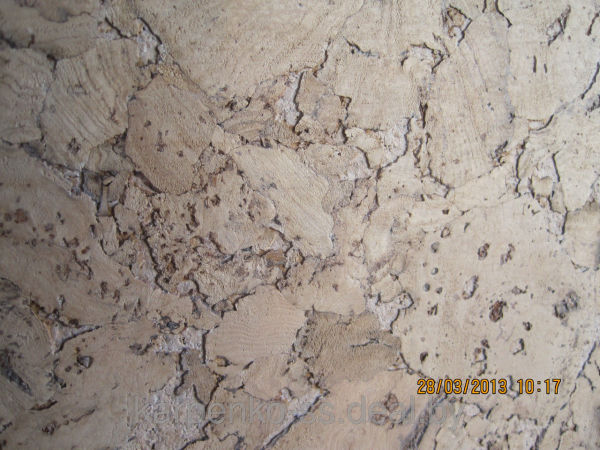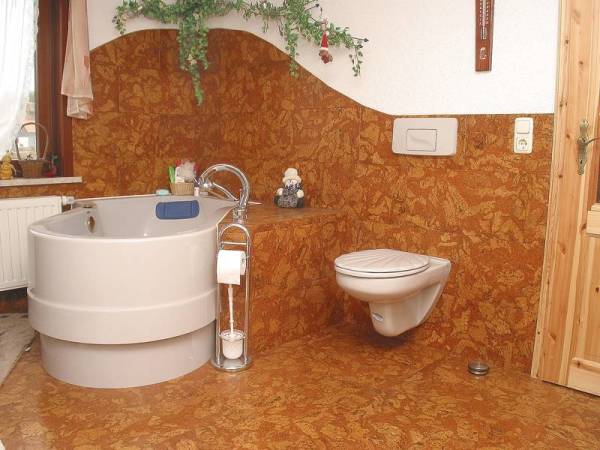Let's see how cork is used for walls.
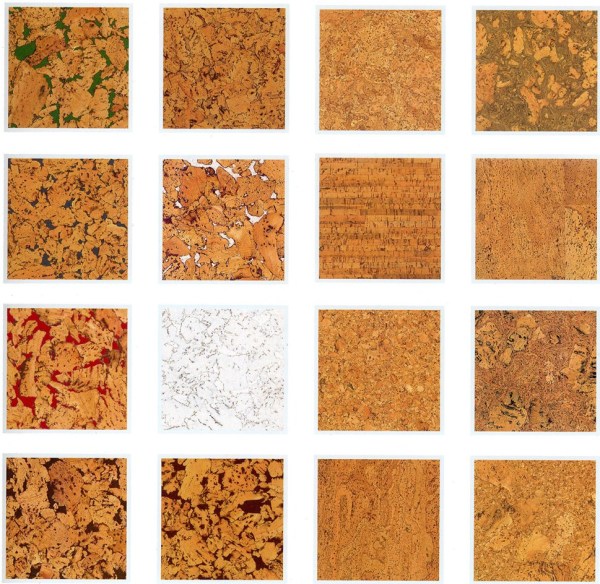
We live in a world that is 80 percent plastic, and in this environment, more and more wanderers of ecological styles appear every day. This applies to both interiors and their decoration, and repair in general. People tend to use only natural, natural materials, although sometimes they are inferior in quality to artificial ones.
In this article we will talk about one of these materials, and try to figure out what cork is for walls, and where it can be used in the house, and where it is better to look for something else.
The content of the article
Such a different cork
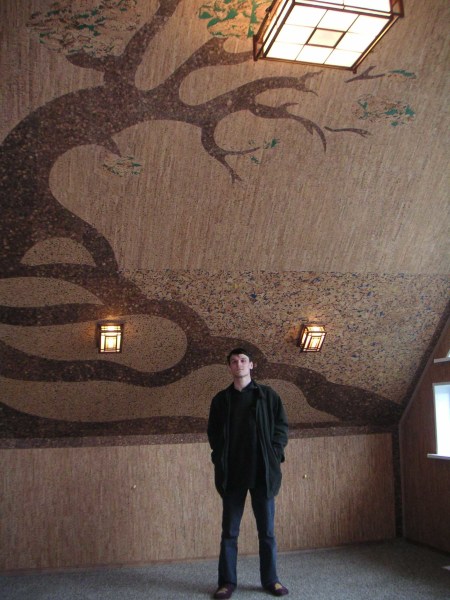
Cork is a material made in a special way from oak bark. It goes through several stages, as a result of which a powder substance is obtained, from which you can create any objects with unique qualities, but the topic of our article is cork on the walls, so we will dwell on the finishing materials.
So, decorative cork for walls is a very generalized concept, which includes a number of different materials, each of which has its own qualitative characteristics, and is intended for use with specific purposes.
Deciding on the choice of coating is quite difficult, and the price here cannot be the final selection criterion, so we will take a short excursion into the world of cork coatings, and try to figure out their purpose:
- Cork Wallpaper. The most common and affordable material. such wallpapers can become a real decoration of the interior, and also have unique qualities unusual for other materials. We will talk about how to glue the cork on the walls a little lower, but immediately note that this process is quite simple, and even those who do not have the appropriate experience can do it.
- The cork on the walls is technical. Strictly speaking, this material cannot be called finishing, since it is used as a substrate for wall or floor covering. It gives the surface additional insulating qualities, and if we talk about floor coverings, then due to its softness, it can significantly extend the service life of parquet or laminate.
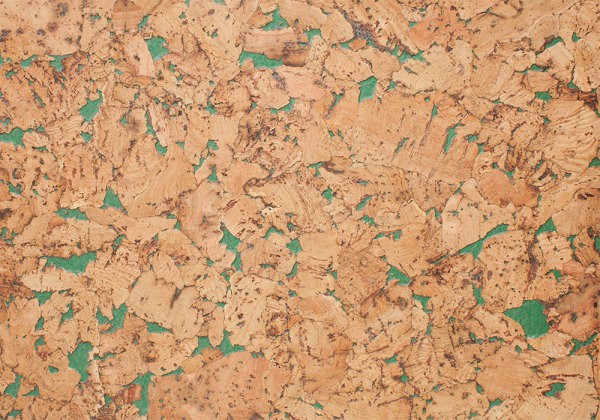
- Cork tile. Not the most convenient finishing material, but thanks to a thickness of at least 6 millimeters, which has improved insulation qualities. Tiles can be of different sizes, and are selected depending on the configuration of the wall that you want to finish.
- Laminate. Yes, yes, this flooring can also be cork. Of course, the laminate is not entirely made of cork, but only its upper part, but this is only a plus, since the laminate manufacturing technology provides for its long-term operation even with increased surface loads.
- Wall panels. The cork is mounted on the walls according to the same principle as the laminate flooring or lining. Each panel has a groove and a comb with which they hold each other. The main difference from the tiles here is the visible seams that give the interior a special look.
- Fluid plug. The process of applying a liquid plug is sprayed, the technology is relatively new, but has already gained popularity. Under such a coating, it is not necessary to carefully align the walls, and in itself it can close many of the flaws present on the surface.
- Decorative panels. Strictly speaking, this element cannot be called decoration material, but such a cork on the wall in the interior can not only decorate it, but also become a key element in the decor.
Advice! When using modular elements for decoration, always start decoration from above, not from below. Otherwise, the segments will press against each other, and bending and deformation, which can lead to cracking, are not excluded.
As you can see, the cork wall concept is very extensive, but not depending on what material you choose, they all have a set of positive and, unfortunately, negative qualities.
Pros of Cork
It:
- Unique insulation performance. Cork serves as an additional insulation and sound insulator both on the walls and on the ceiling. With this material your home will become much more comfortable and quieter.
- Roll cork for walls, as well as modular, is very easy to install, and you can do this with your own hands, for this it’s enough to watch the video in this article, and you can safely get down to business.
- Environmental friendliness. This is what is most appreciated in natural materials. Chemical reagents are not involved in the production of cork coatings, so you can be completely calm about your health and your children.
- High mechanical qualities. One of the unique abilities of cork coatings is the restoration of shape after mechanical deformation.
- Strength. Of course, it is possible to damage the cork coating with a sharp or heavy object, but you will have to make a lot of effort, but you can no longer worry about accidental damage.
- Unique decorative qualities. The cork on the walls in the interior looks very attractive, and even a small wall panel can give the design a completely new look that will appeal to both guests and all households.
- Static Due to the fact that cork production contains exclusively natural materials, it has the ability to repel dust from its surface. This factor is especially relevant if there are people with allergies or even asthma in the house.
Unfortunately, nothing in this world is perfect, and even cork coatings have their drawbacks, which you just need to know about, but in fairness it should be noted that the negative sides of this material are much less than positive ones.
Cons cork

It:
- The main and most significant minus of all cork coverings, regardless of their configuration - this is the price. Of course, such a coating, by definition, can not be cheap, but not everyone can afford it, and if your repair budget has a strict framework, it is better to look for other materials, since there are plenty of them in the modern market.
- A certain difficulty in care. Despite the fact that the cork coating does not attract dust and can be washed, dirt sooner or later begins to accumulate in the porous structure, which is very difficult to remove. That is why we strongly recommend regular cleaning of cork-covered walls.
- To a large extent, gluing the walls with cork in rooms where odors are constantly present is complicated. This material is able to absorb and accumulate them, and getting rid of a kind of amber will not be so simple.Of course, a layer of varnish will help here, but more on that below.
Important! The cork varnish on the wall differs from that used to protect wooden coatings, so you need to choose it very carefully.
So, we figured out the features of this material, and now we can proceed directly to the decoration.
Cork in the interior
Of course, the technical characteristics when choosing building or finishing materials are very important, but you can not forget about the decorative component. In principle, cork coating does not have any serious restrictions on use, and you can decorate it with all the rooms in the house, but there are a number of nuances that you need to know about, especially when it comes to rooms with an initially complex and aggressive environment.
Moreover, for each room, the cork on the walls and floor is selected separately. Somewhere it is best to use wallpaper, and somewhere it will be more rational and profitable to apply spraying or use modular elements.
The point here is not only in external attractiveness, for all types of cork coatings it is up to par, but also for purely applied purposes, because depending on the purpose of the room, the effect on finishing materials also changes. But let's not get ahead of ourselves, and dwell on the main rooms in the house in a bit more detail.
Living room
Cork wall decor is a real open space for the manifestation of your imagination. There are no strict restrictions, since the walls rarely have an increased impact, and the style depends entirely on the owners of the room, who choose the finishing materials.
Here, wallpapers and wall panels will look equally relevant, and if the budget allows, you can also spray. This coating will last much longer and is easier to care for. The only, but very significant difficulty in this case is that you cannot apply such a coating yourself.
Firstly, you will need expensive equipment, which is not advisable to buy for the sake of a one-time repair, and secondly, without certain knowledge and experience, you simply can’t cope with this work, since there are a lot of nuances and subtleties that are known only to professionals.
An interesting solution would be to use cork panels on the walls of the living room. As a rule, the size of this room allows you to use large decor on the walls, and an intricate drawing depicting, for example, a ship or wild animals, as shown in one of the photos in this article, will give the interior a special surroundings and create the right perception for guests and households.
In a word, the living room is a place for experimentation, and the main thing here is to know the measure, and not to overdo it with filling the room.
Bedroom and nursery
The fact that cork is a completely natural material allows it to be used in these rooms where traditionally high demands are placed on the purity of materials for decoration. Moreover, knowing how to properly glue the cork on the wall (see How to glue cork wallpaper yourself correctly), you can protect children from injuries and scratches. Cork - a very soft material, when dropped on which you can not get an abrasion.
Advice! Try to avoid white color in children's rooms. White cork on the walls is perceived by the child as a canvas for drawing, and it is very difficult to remove traces of a marker, felt-tip pen or ballpoint pen from this coating.
As for the parents' bedroom, then cork is a real find, and the point is not only that the decoration of the wall in the bedroom with a cork is room for imagination, but also in a purely practical sense.Cork is a unique sound insulator, and for the parent bedroom, it is sometimes a very important indicator, well, you understand what we are talking about.
Wall panels and thick tiles have the highest level of noise isolation, this indicator is slightly lower for wallpapers, but spraying will allow you to make noise with all your heart, and you won’t have to blush in front of your neighbors in the morning.
By the way, cork laminate can also be used on walls, the main thing is that it does not have parquet imitation, otherwise it will look, to put it mildly, strange. The laminate has high strength indicators, and today, it is increasingly being used for other purposes.
Simply put, pasting a cork on a wall in a bedroom or a nursery is a great solution that you definitely won’t regret.
Kitchen
In terms of decoration, the kitchen is one of the most difficult rooms, which needs a particularly careful approach to the choice of materials. Most often, they use simple painting or vinyl wallpapers, but what if you want something original and warm. In principle, the cork on the walls in the kitchen is quite acceptable, but you need to remember about its ability to absorb foreign odors, which are always enough in this room, even if the cooking stove is equipped with a powerful exhaust hood.
There is a way, and this is a varnish coating. As mentioned above, a varnish is needed here, although you can also use a regular varnish if you wish, but then you can forget about environmental friendliness, because it will create a thick film, which in its characteristics resembles glass, and the glass completely covers the coating, and only the appearance remains .
Special varnish acts a little differently, it is absorbed into the surface and works on the same principle as a deep penetration primer, that is, it protects the cork from the inside, preventing it from absorbing the smell, but does not prevent the condensate from escaping out.
Bathroom
Another difficult room. Unlike the kitchen, there are no pungent odors that the coating could absorb, but the problem is not getting smaller. The main enemy of all natural wall and floor coverings is constant temperature changes and a high level of humidity.
It is impossible to deal with it, otherwise the very meaning of the bathroom disappears, but with the help of the same varnish, you can protect cork walls from destruction and the harmful effects of moisture. The cork on the walls in the bathroom needs even more protection than the one used in the kitchen, therefore it is advisable to make varnish in several stages, that is, cover it with the first layer, allow it to dry well and apply another layer.
Ideally, if there are at least five such passages, of course, this will be reflected in the budget, but you must admit that remodeling all repairs in the bathroom and changing the wall covering will cost much more, and it will take more energy. There is another original solution - use a laminate for wall decoration, which has increased resistance to moisture and can easily withstand constant temperature changes.
Important! The instruction on how to stick a cork on the walls in the bathroom differs from that applicable to less aggressive rooms, as constant humidity can destroy the glue base and trim elements will simply fall off. This must be taken into account, and choose glue based on these criteria.
Hallway
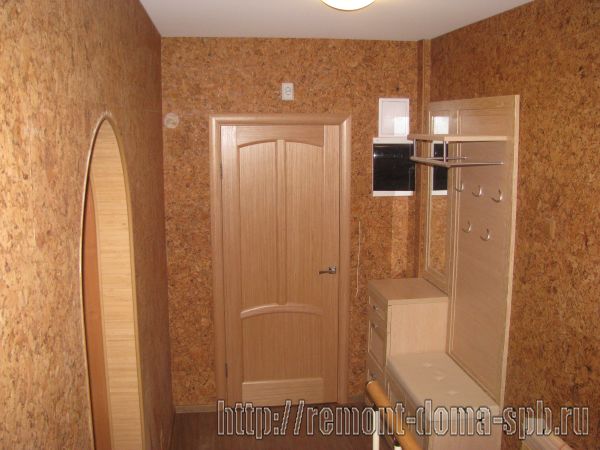
The cork on the walls in the hallway is beautiful, stylish and most importantly practical, but do not forget that this room has the highest degree of load on the walls. Here they are constantly exposed by the touch of hands, and although such effects are not terrible, corrosive dirt can accumulate on the surface over time, getting rid of which will be very, very difficult.
In principle, here you can do without additional protection, but it certainly will not be superfluous, although it will affect the total cost of decoration. The technology of sticker cork on the wall in the hallway will not differ from any other, but as a tip we can say that it is better to refuse from spraying, and give preference to modular coatings.Since in case of contamination or damage, it will be possible to replace only one or several segments, and you will not have to change the entire coating.
